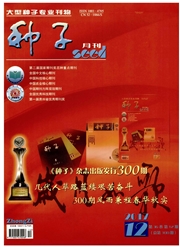

 中文摘要:
中文摘要:
为探索豌豆种皮的结构和成分对种子透水性的影响,借助扫描电镜对种皮表面和横断面结构进行观察,并采用显微化学鉴别法、红外光谱分析法以及能量色散型x射线荧光分析仪对种皮成分进行了定性和定量测定。结果表明,豌豆种脐是水分进入种子的主要通道,而种皮结构中的角质层、栅栏层是水分和其他外源物质进入的主要障碍。种皮成分中纤维素、木质素、角质、含碳化合物和Sr元素等的积累增加了种皮的机械强度,从而降低种子的透水性,而种皮中K、Fe、Ca元素的积累可能有利于种皮透水。此外,研究还发现,皮壳率越高,种子透水性越好,且保持种子种皮完整性对种子吸水和保水具有重要作用。
 英文摘要:
英文摘要:
To explore the effects of seed coat structure and composition on water permeability of pea seed,scanning electron microscope was used to observe surface and cross section of seed coat, and micro-chemical identification, infrared spectrometer and energy dispersive X-ray fluorescence spec- trometer was applied to analyze composition of seed coat qualitatively and quantitatively.The results showed that hilum was the main channel through which water into the seed inside, and cuticle and palisade layers were the main factors that caused the seed coat impermeable. The accumulation of cellulose,lignins,cutin, carbon compounds and Sr element existing in seed coat reduced seed water permeability,while the presence of K,Fe,Ca ions might contribute to the water permeability of seed coat.In addition, seeds with higher husk content had better water permeability. The integrity of the seed coat was crucial to water absorption and retention properties of seed.
 同期刊论文项目
同期刊论文项目
 同项目期刊论文
同项目期刊论文
 期刊信息
期刊信息
